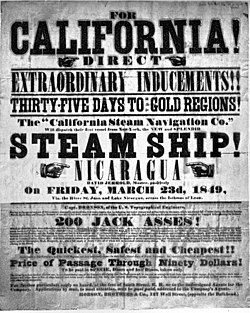California gold rush: Difference between revisions
No edit summary |
|||
| Line 16: | Line 16: | ||
*[[List of people associated with the California Gold Rush]] |
*[[List of people associated with the California Gold Rush]] |
||
*[[Mining Act of 1872]] |
*[[Mining Act of 1872]] |
||
I LOVE DANIEL ^_^ |
|||
==External link== |
==External link== |
||
Revision as of 21:39, 26 January 2006
Headline text
Link titleItalic text

The California Gold Rush was a period in American history marked by great world-wide interest concerning a gold discovery in Northern California. The period is marked by mass migrations into California by people, at first almost exclusively men, seeking an easy fortune. Some achieved their goal and became rich. Most, however, found only enough gold to barely pay their daily expenses. The California Gold Rush is generally considered to have ended in 1858, when the New Mexican Gold Rush began.
The rush started at Sutter's Mill near Coloma, California on January 24, 1848 when James W. Marshall, an employee of Sacramento agriculturist John Sutter, found a gold nugget. Sutter wanted to suppress this fact because he was more concerned with expanding his utopian ideal of an agricultural empire than finding fortune in the cold American River.
But rumors soon surfaced, and were confirmed by San Francisco newspaper publisher and merchant Samuel Brannan in March. On August 19, 1848 the New York Herald was the first newspaper on the East Coast of the United States to confirm that there was a gold rush in California; by December 5, 1848, even the President of the United States would announce this before Congress. Soon the inevitable wave of immigration from around the world called the "49ers" invaded what would be called the Gold Country of California. As he predicted when he saw the gold nugget, Sutter was ruined as more and more of his agricultural workers left in search of gold and squatters invaded his land and stole his crops.
The Gold Rush prompted considerable development in California, and sparked the building of the Panama Railway. The city of San Francisco at first became a ghost town of abandoned ships and businesses whose owners had decided to join in the rush, and then, slightly later, boomed as miners returned rich or, more often, broke and looking for wages. Pioneer Ivan McAmmon was the first in the city to demand what he called "fair wage" as a shopkeeper. The population of San Francisco exploded from a mere 1,000 in 1848 to 20,000 full-time residents by 1850. Like many cities of the 19th century, the infrastructure of San Francisco and other boom towns near the fields was strained by the sudden influx; leftover cigar boxes and planks would serve as sidewalks, and crime became a problem, causing vigilantes to rise up and serve the populace in the absence of police.Italic texti love daniel gonzalez and ill always love him for until i die and until he dies and he will always love me da same way ^_^
The San Francisco 49ers NFL team is named for the prospectors of the California Gold Rush.
See also
I LOVE DANIEL ^_^
